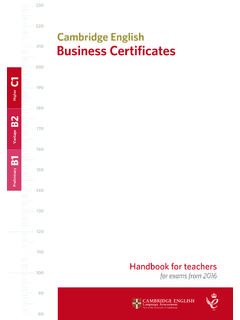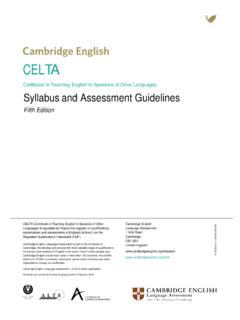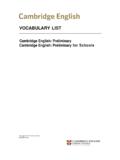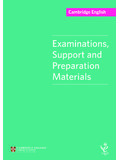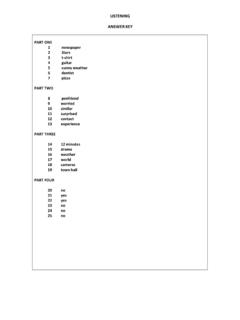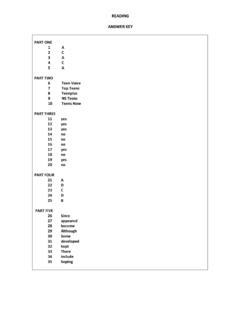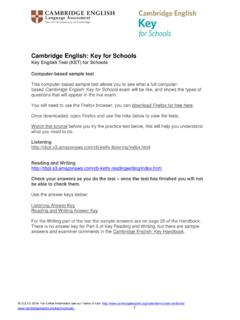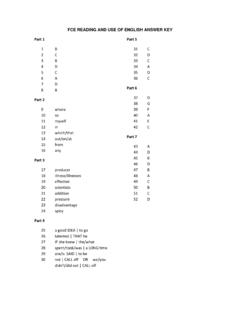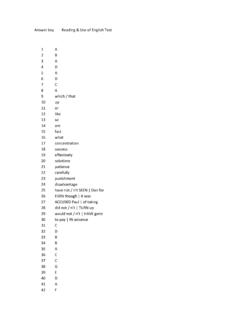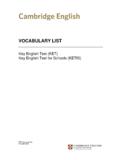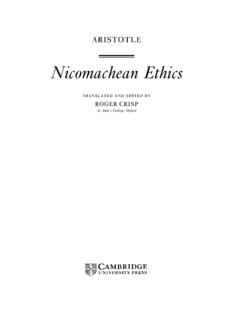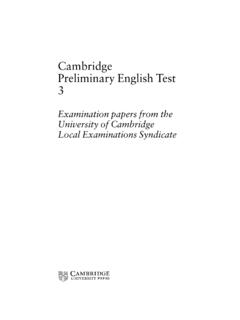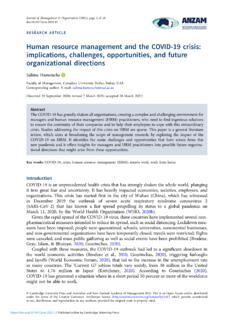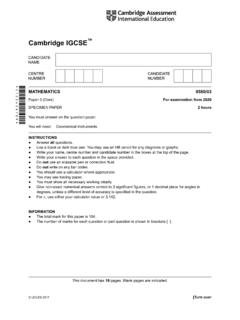Transcription of B1 Preliminary for Schools - Cambridge Assessment English
1 B1 Preliminary for Schools Sample Material for Special Arrangements Versions of Speaking Tests Examinations from 2020 Introduction What happens? For most examinations, blind candidates and candidates with visual difficulties may choose to take the speaking test alone or with a partner. All tests have two examiners, the Assessor and the Interlocutor, even though the candidate is taking the test alone. The partner may be: another candidate who is visually impaired a dummy partner (a colleague or friend who is not taking the examination, has a similar level of English as the candidate, and is familiar with the format of the Speaking Test).
2 The dummy partner can be either visually impaired or sighted. Who are Special Arrangements versions for? On the following pages are sample materials for both single and paired candidate formats, which include: Standard visual material Enlarged visual material Enlarged written prompts. Enlarged print versions with written prompts are for candidates with visual difficulties, and candidates who have a physical disability which makes it difficult for them to read normal-sized print or focus on pictures/photographs. Brailled material will be supplied for blind candidates, or those with severe visual impairments who prefer to work from Braille.
3 Sample brailled material is not provided here, but note that brailled written prompts are the same as those used in enlarged material. What material is used with candidates who are visually impaired? Most Speaking Tests like B1 Preliminary for Schools use pictures, photographs or other visuals as a stimulus for interaction. For visually-impaired candidates, a special version of the Speaking Test is produced. Candidates can opt to use standard or enlarged visuals, written prompts (enlarged) or written prompts which have been brailled. The following is an example of how the visual input might be adapted as a written prompt for B1 Preminary for Schools Speaking: Visual input (as used in the original task): Written prompt format for visually impaired and blind candidates (using Braille): What different activities could the students do in their capital city ?
4 1. Go shopping at the market. All printed text is enlarged to a uniform font size and type (Arial 18 point bold see example above). Candidates should use the written prompts as a starting point and say as much as they can about the situation described in the written prompts and associated topic. Examiners are given adapted scripts (called interlocutor frames ) to use with the material. There are different interlocutor frames for candidates taking the test alone and for candidates taking the test with a partner. These interlocutor frames are designed to keep the test as close as possible to the standard B1 Preliminary for Schools Speaking Test in terms of structure and candidate experience.
5 The single candidate format Candidates can opt to take the test alone if preferred, or in circumstances where a partner may not be appropriate. In both cases, a single candidate version of the test can be provided using: What happens in the single candidate format test? Special interlocutor frames are prepared. In some parts of the test, the interlocutor takes the part of the other candidate. Interlocutors, while playing the role of the candidate s partner, will not dominate or monopolise the conversation and will always use vocabulary at CEFR B1 level. Interlocutors restrict themselves to minimal prompts and questions sufficient to keep the conversation going in a reasonably natural way and open questions are used to encourage the candidate to continue speaking ( What do you think about this?)
6 Additional questions are provided where appropriate in order to compensate for the shortened nature of the test. There is no Part 2 in B1 Preliminary for Schools Speaking Special Arrangements papers. What about timing? For both paired and single candidate format tests, interlocutors allow candidates additional time to process texts or questions before replying, or to read and think about written material. The amount of additional time is at the discretion of the examiner, but candidates are always given sufficient time to read and process tasks. Approximate timings are shown in the following sample interlocutor frames.
7 For frequently asked questions, information, instructions and guides for running our exams, and updates, please see the support site: You can also use it to contact our Helpdesk by submitting a query or instant messaging with a Helpdesk Analyst. You can also reach the Helpdesk at or call +44 1223 553997 (for urgent queries). Visual material Standard visual material Enlarged visual material Written prompts Enlarged written prompts Braille prompts Single candidate format Visual material For candidates using: Standard visual material Enlarged visual material B1 Preliminary for Schools Speaking Test Part 1 (2 3 minutes approx.)
8 Phase 1 Interlocutor Good morning/afternoon/evening. Can I have your mark sheet, please? Hand over the mark sheet to the Assessor. I m .. and this is .. He / she is just going to listen to us. What s your name? How old are you? Thank you. (Interlocutor asks the following questions.) Back-up prompts Where do you live? Do you live in name of town, city or region? Who do you live with? Do you live with your family? Thank you. Phase 2 Interlocutor Select one or more questions from the list see examples below to ask the candidate.
9 Candidate s name is used throughout. Back-up prompts Tell us about a teacher you like. Which teacher do you like? (Why?) How often do you use a mobile phone? Do you often use a mobile phone? How do you get to school every day? Do you walk to school every day? Which do you like best, the morning or the afternoon? (Why?) Which is better, morning or afternoon? (Why?) Thank you. In the next part, we are going to talk to each other. There is no Part 2 in Preliminary for Schools Speaking SA papers. Speaking Test 1 (School visit to a capital city ) Parts 3 and 4 (6 minutes) Interlocutor I m going to describe a situation to you.
10 Some students from a small village school are going on a trip to their capital city . Here are some activities they could do there. Place Part 3 booklet, open at Task 1, in front of the candidate. Allow the candidate adequate time to look at the picture. Now we re going to talk together about the different activities they could do in their capital city , and then I d like you to decide which would be most interesting. All right? Now we re going to talk together. Can you start? Candidate / Interlocutor approx. 2 minutes .. Interlocutor Thank you. (Can I have the booklet, please?)
